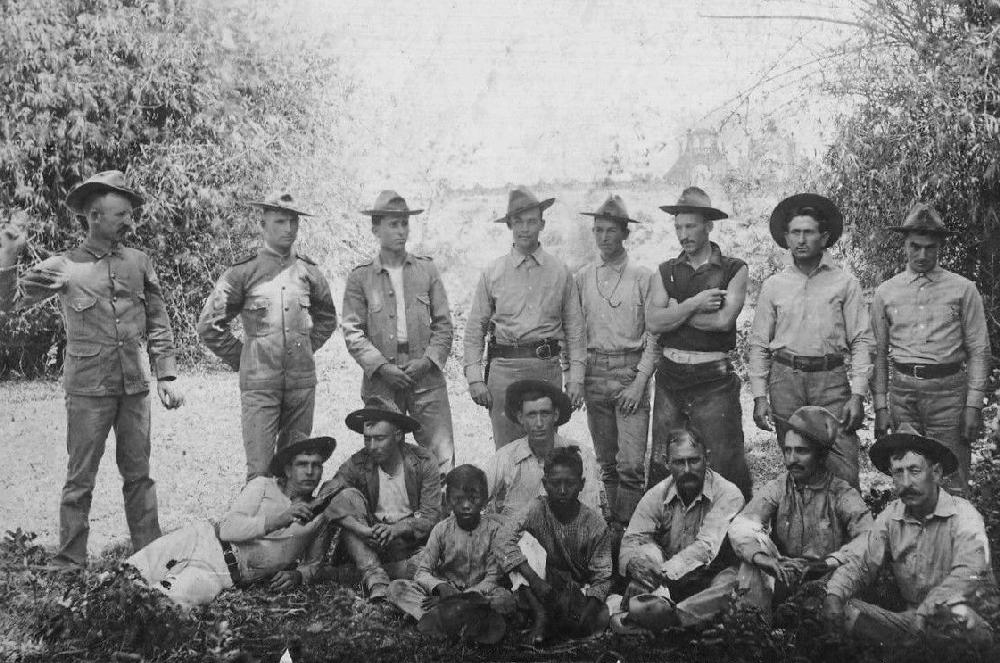
Spanish-American War--Island Campaigns--Philppines (1898)

Figure 1.--Here we see a cabinet card portrait of American soldiers in the Philppinrs, probably a few years after the war with Spain. They have made friends with twp Filipino boys. The card mount helps to date the prtrait to the early-20th century. we are not sure if this is an outdoors portrait or a studio mockup.
|
|
The first action of the Spanish American War occured in thePhilippines. The Spanish-American War was all about Cuba. Cuban revolutionaries had launched their struggle (1895) and the repressive Spanish actions to defeat the rebellion attracted the attention of American newspapers. There were no articles on the Philippines or even Puerto Rico. American public opinion began to demand war with Spain which reached a crechendo after the battleship USS Maine blewup in Havana harbor (February 15). The United States and Spain declared war (April 24-25). The first action of the War, however, occurred far way from Cuba primarily because Adm. Dewey engaged the Spanish fleet in port. Dewey had only recently been given command of the Pacific Squadron. He felt like most ranking officers that war with Spain was imminent, largely because of the press reporting. Dewey assumed that it would be an Atantic war. [Lawrence]
Dewey reached the Squadron in Hong Kong (December 1897). He began preparing for the war he saw coming. A,most immediately the Navy Department began to sending instructions (January 1898). John D. Long was the Secretary of the Navy. Some of the instructions came from Assistant Secretary of the Navy Theodore Roosevelt, acting without instructions from Long or President McKinnely. Upon the outbreak of war, the Navy Department ordered Dewey;s Pacific Squandron to engage the Spanish Fleet at Manila Bay. Dewey was in Hong Kong and immediately sailed for the Philippines where an insurection against the Spanish was also underway. On board Dewey's flagship was Philipino rebel Emilio Aguinaldo. The Battle for Manila Bay began with Dewey's orders, "Fire when ready Grudley." (May 1) Dewey destoyed the Spanish Fleet and harbor batteries (May 1). There were no American casualties. Dewey had no land force with which to occupy the islands and the Spanish refused to surrendr. Aguinaldo's guerrillas engaged the Spanish forces. Finally an American land force of 15,000 troops (late-July). The United States did not want the insurgent Filipinos to seize power. There was at first an uneasy alliance between insurgent Filipino and U.S. forces led to a Spanish surrender (August 14).
Sources
Lawrence, Willian J. A Concise Life of Admiral George Dewey (1899).
CIH

Navigate the Children in History Website:
[Return to Main Spanish-American War page]
[Return to Main 19th century American history page]
[Return to Main Cuban history page]
[About Us]
[Introduction]
[Biographies]
[Chronology]
[Climatology]
[Clothing]
[Disease and Health]
[Economics]
[Geography]
[History]
[Human Nature]
[Law]
[Nationalism]
[Presidents]
[Religion]
[Royalty]
[Science]
[Social Class]
[Bibliographies]
[Contributions]
[FAQs]
[Glossaries]
[Images]
[Links]
[Registration]
[Tools]
[Children in History Home]
Created: 9:49 AM 2/10/2016
Last updated: 9:49 AM 2/10/2016



